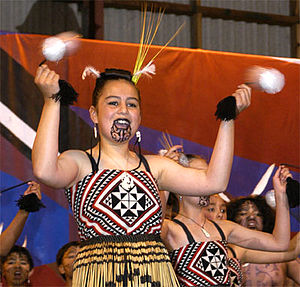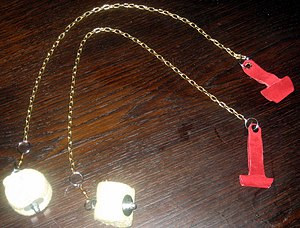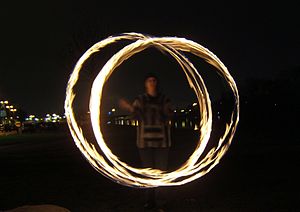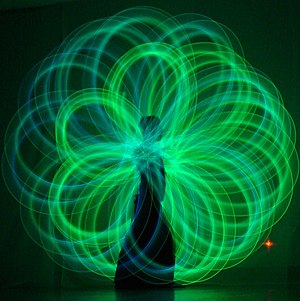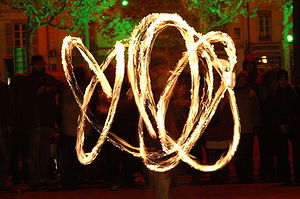AY Honors/Māori Lore/Answer Key
Poi is a form of juggling with balls on ropes, held in the hands and swung in various circular patterns, similar to club-twirling. It was originally practiced by the Māori people of New Zealand (the word poi means "ball" in Māori). Women used it as an exercise to increase flexibility of the wrists and hands, and men used it to increase strength in the arms and coordination. It developed into a traditional performance art practiced mostly by women. This art in conjunction with others like waiata a ringa, haka and titi torea form the performance art of Kapa haka.
Modern poi
Today, poi extends far beyond the original Māori culture. In juggling circles, a whole subculture has sprung up in some places, surrounding poi spinning as a hobby, exercise, or performance art. Poi is considered a form of juggling, and poi dancers can often be found performing alongside jugglers, staff spinners and other similar performers.
Practice poi
Many people start out using a simple pair of practice poi. These are usually constructed from something soft, in order to lessen the frequency of beginners suffering the inevitable minor bruises. Rolled up socks, bean bags or small soft toys on strings are often used. Generally, poi spinners start out with very simple moves, gradually learning to involve more complexity and (eventually) a full performance routine. Many find it helpful to practice spinning their poi to music, in order to keep a good rhythm.
Performance poi
Dancers and performers use brightly coloured poi, home made or bought at juggling shops, or a number of online stores. Fluorescent coloured tails and streamers attached to the poi allow a number of beautiful patterns to be created in the air by the performer, and many spinners pride themselves on the patterns they can make, and the accuracy of their spinning. A number of different forms of poi can be bought, from brightly coloured cones, to cloth blades that can look like dragonfly wings.
A variation on this is with 'Flag poi', consisting of large sheets of lightweight fabric which can be spun round in the same way as regular poi. Often made of reflective or UV-sensitive material, these spin quite slowly and can create the effect that the performer is wrapped in sheets of rippling fabric. The weight and drag created by these flags, however, necessitates the spinner to ensure precision of movement and timing. Consequently, they are difficult for the beginner to grasp.
Glow poi
Glow in the dark poi are available from a number of places, as are glow in the dark gloves, UV sensitive poi and poi containing LED lights that make them shine. Different types of poi can be used to create different effects, depending on the setting. Poi containing small strobes, for instance, can be used to create special effects.
By far the simplest method used is a pair of glow sticks attached to strings. Glow stick poi are popular at festivals and raves, and some brands of glow stick even come with ribbons in the packets, which many find to be ideal.
Fire poi
Considered by some to be the "ultimate" performance poi, fire poi are constructed from chain, with kevlar wicks that can be soaked in fuel (usually paraffin, kerosene or a similar household fuel - gasoline is not used as it both burns too quickly for either safety or performance longevity and is much more toxic) and set on fire. Fire performances are considered breathtaking and exhiliarating feats for both audience and performer, provided the poi spinner is competent and confident enough that they can control the fire poi without putting anyone (particularly themselves) at risk.
Many kinds of fire poi are available, the simplest utilising two wicks. The fire wicks are generally one of three varieties: a cylindrical wrap, cathedral stack (square) or a monkey fist knot tied with kevlar rope. Some experienced performers like to pick and choose their wicks, according to the performance they intend to give - controlling their burn time and the brightness of the flames. More advanced fire poi can have multiple wicks.
A variation called fire snakes consists of a length of kevlar rope that can produce a long flame. These can look stunning when used by a skilled performer, resulting in them being surrounded by sheets of brilliant flame.
Sock poi
Sock poi are made from tubes of fabric (frequently socks), with a ball or weight on one end, and knots for counterweight and grip on the other end. Many performers use a form of sock poi for practice purposes, because the light weight and soft texture prevent injury during mishaps. However, many performers find the weight and stretch of sock poi to be ideal for more difficult tricks and moves, such as tangles, wraps, and throws, that may be hampered by a rigid cable or chain.
Poi Moves
Template:Main As with many subculture sports and pastimes, poi spinners often spend hours mastering their tricks, gaining respect from their peers for managing more impressive stunts.
Some popular poi tricks include: reels, weaves, fountains, crossovers and windmills.
Split time and split direction moves are possible, and some of the more difficult moves require a considerable amount of manual dexterity, coordination and forearm strength to accomplish.
There are several basic classes of trick. The two poi are usually spun in parallel planes, and can be spun in the same direction (weaves) or opposite directions (butterflies). Moves such as stalls and wraps can change direction of one (or both poi) to change between these two classes.
Weaves
Weaves are a class of trick based around the "basic weave". Considered by many poi swingers to be one of the staple moves, the basic (3 beat) weave is often one of the first tricks learned. The basic weave is called "three-beat" because each poi spins three times in a cycle: once on the same side of the body (eg left hand poi on left side) and twice on the opposite side. Backwards weaves, behind the back weaves, and 2-beat, 4-beat, 5-beat, and other weaves are also possible.
Butterflies
The butterfly is a simple trick where the hands are held close together in front of the spinner and the poi spin in opposite directions flat to the spinner so that the poi cross at the top and bottom of their circles. This move can be done behind the head, behind the back and extended to any number of moves; there are as many variations on the butterfly possible as there are for the weave.
Wraps
A wrap is a move where one or both poi are wrapped around something, most typically part of the body, to change the path or direction of spin. There are two types of wrap - basic or recoil wraps wrap around the target and then bounce off so that the poi ends up spinning in the opposite direction to which it started from, and thru-wraps which wrap around a moving body part so that the direction stays the same but the poi changes the path it is travelling along. Typical targets for a wrap are the arms and legs, although any body part is suitable - one of the more dangerous places to perform wraps is around the neck. Double neck thru-wraps are perhaps the most dangerous move that can be done with fire poi due to the risk of the poi tangling.
Flowers
Flowers are a simple but visually impressive set of moves in which the poi spinner fully extends their arms and moves them in circles around the body while spinning the poi. When done in time this gives rise to a series of loops around a large circle, which look like the petals of a flower when viewed from the side.
Further Moves
Isolations refer to a class of moves where the poi handle is also spun in a circle. 'Perfect' isolation occurs when the poi handle and poi are moving in the same circle, and can usually create increadibly beautiful synchronised moves (eg cranks). Hyperloops (or knots) are where the poi ropes becomes entangled (twisted up) and then untangled, keeping the ends spinning the entire time. Advanced spinners are even able to spin their moves in places such as behind the back and between the legs.
Poi construction
Many poi spinners, amateur and professional alike, prefer to create their own poi. A simple pair of practice poi require little more than a pair of socks and a couple of tennis balls. More impressive poi can be made from a multitude of different materials. Kite cords are lightweight and readily available. Chain is a more durable alternative to regular cord, ball chains can rotate freely so as to prevent tangling and metal cables can make for extremely fast poi. Long socks can also be used with a weight in one end and a knot in the other. More advanced spinners may add a weight to the handle, in order to improve their ability to perform advanced techniques (such as throws and contact poi).
Kevlar wicks and a variety of poi heads can be bought either from juggling shops, or online, and a number of different kinds of hand grip are available too. This way a performer can customise their poi to suit their own personal preference.
Following are a number of arts from different cultures that bear an affinity to poi.
- Staff
Staffers are one of the largest factions in the juggling community. In a similar way to poi spinners, staff spinners use one or two staffs to make a variety of patterns. Staffs, being large blunt objects, are known for being slightly more dangerous than poi when beginning, but many find they prefer staff tricks once experienced. Many similar techniques can be employed to those found in martial arts like bojutsu.
- Glowstringing
Glowstringing is a similar art to poi, largely developed and advocated by the rave community, before spreading throughout electronic music culture. It involves spinning glowsticks to make patterns in the air at raves or in the club scene. While often mistaken for poi, it is in fact a separate discipline, and the two styles have had some influence on each other.
- Club swinging
Using regular juggling clubs, the head of the club can be held in the palm, and the club swung in poi-like patterns. Many poi moves can be attained this way, and as clubs can be stopped at any point of their swing, or swung as slowly as you like, some poi spinners find them useful in learning more difficult poi moves in 'slow motion'. Club swinging is, however, a completely separate discipline with its own techniques and performers.
- Sword spinning
Taking influence from the sword displays of the Shaolin monks, some performers learn to do tricks with swords. Swords require a lot more suppleness of the wrists, but can be far faster and more dramatic than poi performances. Practicing with bokken (Japanese wooden practice swords) or simple wooden staves is advisable, but when a performer is skilled enough, fire swords can be bought and constructed. However, swords, being weapons, should be treated with respect and not taken too lightly.
- Nunchaku
The osakan nunchaku, as used by Bruce Lee, employ many similar techniques to poi. While originally a weapon used to fight the Japanese, some companies now produce LED-lit nunchaku which can be used to create unique patterns in performances. Nunchaku are also weapons and should be treated as such.
- Meteor
A meteor (known to martial artists as a meteor hammer) is long rope, weighted on both ends, often with a monkeyfist knot. It can be used similarly to poi as well as a staff, by keeping very precise timing so that the two balls exert equal centripetal force on each other and move in sync. Originally a Chinese weapon, meteor are extremely difficult to control. Fire meteors and other variations of this tool also exist.
Safety
Depending on their construction, poi can strike the user (or bystanders) with enough force to cause bruising or minor injury. Fire poi can cause burns because the metal parts become very hot and have a very high heat transfer coefficient. The actual wick has a lower coefficient and is less likely to cause burns, but it can spray or spread fuel and the performer's clothing can catch fire. Costumes for fire spinning should be made of non-flammable materials, such as cotton and leather. Synthetic fibers tend to melt when they burn and can cause very severe burns.
Fire poi require a safety regime to deal with the risks of setting on fire either the user, bystanders, or the surroundings. All fire performances should have a sober, rested, and alert spotter who has access to a fire extinguisher (for putting out material and fuel fires), a damp towel (for extinguishing burning clothes and for extinguishing fire toys at the end of a performance), and a bucket of water (in case a clothing fire gets out of control. The fuel dump should be a metal container located far from the performance area that can quickly be sealed so as to be airtight. This will provide a means to extinguish a fire in the fuel dump. A paint can is an ideal example.
See also
External links
- Maori.org.nz Traditional Māori poi performance
- Home of Poi One of the largest and most influential poi communities in the world.
- Spherculism~ Advancing the moving arts
- Tribe.net's Art of Poi Forum, photo gallery, and event calendar.
- Glowsticking.com Forums, videos, and tutorials specific to glowstringing.
- Fire Poi World-wide fire poi trainers & performers.
- PlayPoi Poi website featuring videos and photos, both artistic and instructional
- Do More Poi Poi Lessons, Forums, Funkiness.
- The Encyclopoidia dedicated poi wiki with detailed list of moves. (link is dead)
bg:Пой da:Poi de:Poi fr:Poi he:פוי nl:Poi ja:スイングジャグリング nn:Poi ru:Пои sv:Poi
